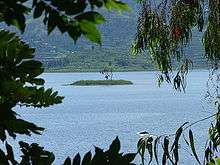Lake Bunyonyi
| Lake Bunyonyi | |
|---|---|
.jpg) | |
| Location | South-western Uganda |
| Coordinates | 1°17′S 29°55′E / 1.283°S 29.917°ECoordinates: 1°17′S 29°55′E / 1.283°S 29.917°E |
| Type | fresh water |
| Basin countries | Uganda |
| Max. length | 25 km (16 mi) |
| Max. width | 7 km (4.3 mi) |
| Surface area | 46 km2 (18 sq mi)[1] |
| Average depth | 39 m (128 ft)[1] |
| Max. depth | 130 ft (40 m)[2] |
| Shore length1 | 186 km (116 mi)[1] |
| Surface elevation | 1,962 m (6,437 ft) |
| 1 Shore length is not a well-defined measure. | |

Lake Bunyonyi ("Place of many little birds") is in south-western Uganda between Kisoro and Kabale, and it is close to the border with Rwanda. The lake appears on the 5,000 Ugandan shilling note under the title "Lake Bunyonyi and terraces".
Towns on its shores include Kyevu and Muko, while its 29 islands include Punishment Island and Bushara Island.
Geography

Lake Bunyonyi is a body of water 7 kilometres (4.3 mi) west of Kabale town.
Main islands
Akampene (Punishment Island)

The Bakiga used to leave unmarried pregnant girls on this small island with - to die of hunger or while trying to swim to the mainland (swimming skills were rare).[3] This was to intimidate the rest, to show them not to do the same. A man without cows to pay the bride price could go to the island and pick up a girl.[3] The practice got abandoned in the first half of the 20th century.[3]
.jpg)
Bwama and Njuyeera (Sharp's Island)
In 1921, English missionary Leonard Sharp came to this part of Uganda and in 1931 established a leprosy treatment centre on the then uninhabited Bwama island.[4] A church, patient quarters (model villages), and a medical facility were built, while Sharp settled on Njuyeera Island (probably meaning "white cottage" after the similarity of the doctor's small white house to Sharp's father's house in Shanklin, now The White House Hotel). The rationale of the leprosy colony was that of "voluntary segregation'", where the provision of a happy community to live in would attract leprosy sufferers, so removing them from the communities where they might infect others.[5]
References
- 1 2 3 UNEMA 2009, p. 94.
- ↑ Visser 1962, p. 81.
- 1 2 3 "Uganda's Punishment Island: 'I was left to die on an island for getting pregnant'". BBC. 24 April 2017. Retrieved 24 April 2017.
- ↑ Not a gap year but a lifetime. Katherine Makower. 2008. Apologia Publications, Eastbourne, UK.
- ↑ Island of miracles. Leonard Sharp. 2nd Ed. Battley Brothers Limited, Queensgate Press, Clapham Park, SW4
Sources
- UNEMA (2009), Uganda: Atlas of our Changing Environment (PDF), Uganda National Environment Management Authority, p. 94
- Visser, S.A. (1962), "Chemical Investigations into a System of Lakes, Rivers and Swamps in S.W. Kigezi, Uganda", East African Agricultural and Forestry Journal, 28 (2): 81–86, doi:10.1080/00128325.1962.11661848
External links
| Wikimedia Commons has media related to Lake Bunyonyi. |
- https://www.youtube.com/watch?v=459-IrnCR5Y - a beautiful video about lake Bunyonyi
- http://www.bunyonyi.org - A guide To Lake Bunyonyi